The Environmental Impact of a Complex Hydrogeological System on Hydrocarbon-Pollutants’ Natural Attenuation: The Case of the Coastal Aquifers in Eleusis, West Attica, Greece
Abstract
1. Introduction
2. BTEX Characteristics and Fate into the Aquifers
3. Geology and Hydrogeological Characteristics of the Study Area
4. Materials and Methods
5. Results and Discussion
6. Conclusions and Suggestions
Supplementary Materials
Author Contributions
Funding
Conflicts of Interest
References
- Makri, P.; Kalivas, D.; Bathrellos, G.; Skilodimou, H. Spatio-temporal analysis of groundwater pollution from BTEX Thriassion Field, Attica, Greece. In Proceedings of the 10th IAEG International Congress, Nottingham, UK, 6–10 September 2006. [Google Scholar]
- Karavitis, C.A.; Bosdogianni, A.; Vlachos, E.C. Environmental management approaches and water resources in the stressed region of Thriassion, Greece. Glob. NEST J. 2001, 3, 131–144. [Google Scholar]
- Ιliopoulos, V.; Stournaras, G.; Stamatis, G. Marine and Human Activity Effects on the Groundwater Quality of Thriassio Plain, Attica, Greece. In Advances in the Research of Aquatic Environment; Lambrakis, N., Stournaras, G., Katsanou, K., Eds.; Springer: Berlin/Heidelberg, Germany, 2011; Volume 2, pp. 409–416. [Google Scholar] [CrossRef]
- Pavlidou, A.; Simboura, N.; Pagou, K.; Assimakopoulou, G.; Gerakaris, V.; Hatzianestis, I.; Panayotidis, P.; Pantazi, M.; Papadopoulou, N.; Reizopoulou, S.; et al. Using a holistic ecosystem-integrated approach to assess the environmental status of Saronikos Gulf, Eastern Mediterranean. Ecol. Indic. 2014, 96, 336–350. [Google Scholar] [CrossRef]
- Karavoltsos, S.; Kalambokis, E.; Sakellari, A.; Plavšić, M.; Dotsika, E.; Karalis, P.; Leondiadis, L.; Dassenakis, M.; Scoullos, M. Organic matter characterization and copper complexing capacity in the sea surface microlayer of coastal areas of the Eastern Mediterranean. Mar. Chem. 2015, 173, 234–243. [Google Scholar] [CrossRef]
- Antonarakou, A.; Kontakiotis, G.; Zarkogiannis, S.; Mortyn, P.G.; Drinia, H.; Koskeridou, E.; Anastasakis, G. Planktonic foraminiferal abnormalities in coastal and open marine eastern Mediterranean environments: A natural stress monitoring approach in recent and early Holocene. J. Mar. Syst. 2018, 181, 63–78. [Google Scholar] [CrossRef]
- Karageorgis, A.P.; Botsou, F.; Kaberi, H.; Iliakis, S. Geochemistry of major and trace elements in surface sediments of the Saronikos Gulf (Greece): Assessment of contamination between 1999 and 2018. Sci. Total Environ. 2020, 717, 137046. [Google Scholar] [CrossRef] [PubMed]
- Mavrakis, A.; Theoharatos, G.; Asimakopoulos, D.; Christides, A. Distribution of trace metals in the sediments of Elefsis Gulf. Medit. Mar. Sci. 2004, 5, 151–158. [Google Scholar] [CrossRef]
- Sklivagou, E.; Varnavas, S.P.; Hatzianestis, I.; Kanias, G. Assessment of Aliphatic and Polycyclic Aromatic Hydrocarbons and Trace Elements in Coastal Sediments of the Saronikos Gulf, Greece (Eastern Mediterranean). Mar. Geosources Geotechnol. 2008, 26, 372–393. [Google Scholar] [CrossRef]
- Katsinis, D. Light Hydrocarbon Tracing by Gas Chromatography Method. Contribution to Field Research and to Technical Works-Museum-Environment Protection. Ph.D. Thesis, Athens Polytechnic School, Athens, Greece, 1994; pp. 1–91. [Google Scholar]
- Nakos, G. Pollution of soil and vegetation in the Thriasian Plain, Greece. Plant Soil 1982, 66, 271–277. [Google Scholar] [CrossRef]
- Kontoyiannis, H. Observations on the circulation of the Saronikos Gulf: A Mediterranean embayment sea border of Athens, Greece. J. Geophys. Res. 2010, 115. [Google Scholar] [CrossRef]
- Evangeliou, N.; Florou, H.; Scoullos, M. A preliminary study of particle dynamics in the water column of Saronikos Gulf, Greece, by using Th-234/U-238 disequilibrium approach. Desalin. Water Treat. 2010, 13, 290–302. [Google Scholar] [CrossRef]
- Scoullos, M. Lead in coastal sediments-the case of Elefsis Gulf. Sci. Total Environ. 1986, 49, 199–219. [Google Scholar] [CrossRef]
- Scoullos, M.; Pavlidou, A. Metal speciation studies in a brackish/marine interface system. Glob. Nest 2000, 2, 255–264. [Google Scholar]
- Stathopoulou, E.; Dasenakis, M.; Scoullos, M. Total and methyl-mercury in water samples from Elefsis Gulf, Greece. In Proceedings of the 13th International Symposium on Environmental Pollution and Its Impact on life in the Mediterranean Region (MESAEP), Thessaloniki, Greece, 8–12 October 2005; pp. 119–127. [Google Scholar]
- Galanopoulou, S.; Vgenopoulos, A.; Conispoliatis, N. Anthropogenic Heavy Metal Pollution in the Surficial Sediments of the Keratsini Harbor, Saronikos Gulf, Greece. Water Air Soil Pollut. 2009, 202, 121–130. [Google Scholar] [CrossRef]
- Kounis, G.; Siemos, N. Spot Hydrogeological Survey of Thriassion Plain Aquifers for the Water Supply Needs of the Greek Aspropyrgos Refinery; Institute of Geological and Mineral Explorations: Athens, Greece, 1991. (In Greek) [Google Scholar]
- Valavanidis, A.; Vlachogianni, T.; Triantafyllaki, S.; Dasenakis, M.; Androutsos, M.; Scoullos, M. Polycyclic aromatic hydrocarbons in surface seawater and in indigenous mussels (Mytilus galloprovincialis) from coastal areas of the Saronikos Gulf (Greece). Estuar. Coast. Shelf Sci. 2008, 79, 733–739. [Google Scholar] [CrossRef]
- Aivalioti, M.; Gidarakos, E. In-well air sparging efficiency in remediating the aquifer of a petroleum refinery site. J. Environ. Eng. Sci. 2008, 7, 71–82. [Google Scholar] [CrossRef]
- U.S. Environmental Protection Agency. Chemicals Evaluated for Carcinogenic Potential; Office of Pesticide Programs, Health Effects Division: Washington, DC, USA, 2004; pp. 1–40.
- U.S. Environmental Protection Agency. National Drinking Water Standards; 816-F-02-017; Office of Water: Washington, DC, USA, 2002. Available online: https://www.epa.gov/ground-water-and-drinking-water/national-primary-drinking-water-regulations (accessed on 2 September 2020).
- ATSDR (Agency for Toxic Substances and Disease Registry). Toxicological Profile for Benzene; U.S. Public Health Service: Atlanta, GA, USA, 1989.
- Zhao, B.; Huang, F.; Zhang, C.; Guoxin, H.; Qiang, X.; Fei, L. Pollution characteristics of aromatic hydrocarbons in the groundwater of China. J. Contam. Hydrol. 2020, 233, 103676. [Google Scholar] [CrossRef]
- Chakraborty, R.; Coates, J.D. Anaerobic degradation of monoaromatic hydrocarbons. Appl Microbiol. Biotechnol. 2004, 64, 437–446. [Google Scholar] [CrossRef]
- Salanitro, J.P. The role of bioattenuation in the management of aromatic hydrocarbon plumes in aquifers. Groundw. Monit. Rev. 1993, 13, 150–161. [Google Scholar] [CrossRef]
- Chen, T.C. Understanding the fate of petroleum hydrocarbons in the subsurface environment. J. Chem. Educ. 1992, 69, 357. [Google Scholar] [CrossRef]
- Katsikatsos, G.; Mettos, A.; Vidakis, M.; Dounas, A.; Pomoni, F.; Tsaila-Monopolis, S.; Skourtsi-Koroneou, V. Geological Map of Greece, in Scale 1:50.000. “Athina-Elefsis” Sheet; Institute of Geological and Mineral Explorations (IGME) Publication: Athens, Greece, 1986. [Google Scholar]
- Mariolakos, H.; Theocharis, D. Shifting shores in the Saronic Gulf during the last 18,000 years and the Kychreia paleolimni. In Proceedings of the 9th International Conference, Bulletin of Hellenic Geological Society XXXVI 1, Athens, Greece, 26–28 September 2001; pp. 405–413. [Google Scholar]
- Dounas, A. The Geology Between Megara and Erithres Area; PhD National and Kapodistrian University of Athens: Athens, Greece, 1971. [Google Scholar]
- Hermides, D.; Kyriazis, D.; Makri, P.; Ermidou, A. Geochemical evolution of the Thriassion Plain groundwaters, Attica, Greece. Environ. Monit. Assess. 2020, 192, 561. [Google Scholar] [CrossRef]
- Zacharias, A.; Sarandakos, J.; Andre, C. Report on Sample Drilling and Morphotectonics Study in the Area Around Koumoundourou Lake; 2nd Technical Report; Hellenic Center for Marine Research/IIW Anavyssos: Attica, Greece, 2003. [Google Scholar]
- Lambeck, K. Sea Level change and shore-line evolution in Aegean Greece since Upper Palaeolithic time. Antiquity 1996, 70, 588–611. [Google Scholar] [CrossRef]
- Deligiannakis, G.; Papanikolaou, I.D.; Roberts, G. Fault specific GIS based seismic hazard maps for the Attica Region, Greece. Geomorphology 2018, 306, 264–282. [Google Scholar] [CrossRef]
- Dounas, A.; Panagiotides, G. Precursor Report on the Hydrogeological Conditions of Thriassion; Institute of Geology and Subsurface Research: Athens, Greece, 1964. [Google Scholar]
- Parashoudis, V. Hydrogeological Study of Western Attica; Agricultural Ministry of Greece: Athens, Greece, 2002; p. 165. [Google Scholar]
- Hermides, D.; Mimides, T.; Stamatis, G. Contribution to hydraulic characteristics of Plio-Pleistocene deposits of Thriassion Plain of Attica. Bull. Geol. Soc. Gr. 2016, 50, 967–976. [Google Scholar] [CrossRef][Green Version]
- Ηermides, D. Hydrogeological Conditions of the Thriassion Plain Basin with Emphasis on the Geohydraulic Characteristics of the Aquifers and the Groundwater Quality. Ph.D. Thesis, Agricultural University of Athens, Athens, Greece, 2018; p. 283. [Google Scholar]
- Hermides, D.; Stamatis, G. Origin of halogens and their use as environmental tracers in aquifers of Thriassion Plain, Attica, Greece. Environ. Earth Sci. 2017, 76, 306. [Google Scholar] [CrossRef]
- Hermides, D.; Makri, P.; Kontakiotis, G.; Antonarakou, A. Advances in the coastal and submarine groundwater processes: Controls and environmental impact on the Thriassion Plain and Eleusis Gulf Attica. Greece. J. Mar. Sci. Eng. 2020, 8, 944. [Google Scholar] [CrossRef]
- U.S. Environmental Protection Agency. Methods for the Determination of Organic Compounds in Drinking Water—Method 524.2; U.S. Environmental Protection Agency: Washington DC, USA, 1992.
- Arthur, C.; Killam, L.; Motlagh, S.; Lim, M.; Potter, D.; Pawlizyn, J. Analysis of substituted benzene compounds in groundwater using Solid Phase Microextraction. Environ. Sci. Technol. 1992, 26, 979–983. [Google Scholar] [CrossRef]
- Zhang, Z.; Yang, M.J.; Pawliszyn, J. Analysis of organic compounds in environmental samples by Headspace Solid Phase Microextraction. J. High Resol. Chromatogr. 1993, 16, 689–692. [Google Scholar] [CrossRef]
- Makri, P. The Investigation of Petroleum Hydrocarbons in the Neogene-Quaternary Deposits of the Thriassian Plain. Ph.D. Thesis, National and Kapodistrian University of Athens, Athens, Greece, 2008; p. 265. [Google Scholar]
- Kaplan, I.; Galperin, Y.; Lu, S.-T.; Lee, R.-P. Forensic Environmental Geochemistry: Differentiation of fuel-types, their sources and release time. Org. Geochem. 1997, 27, 289–317. [Google Scholar] [CrossRef]
- Odermatt, J. Natural chromatographic separation of benzene, toluene, ethylbenzene and xylenes (BTEX compounds) in a gasoline contaminated ground water aquifer. Org. Geochem. 1994, 21, 1141–1150. [Google Scholar] [CrossRef]


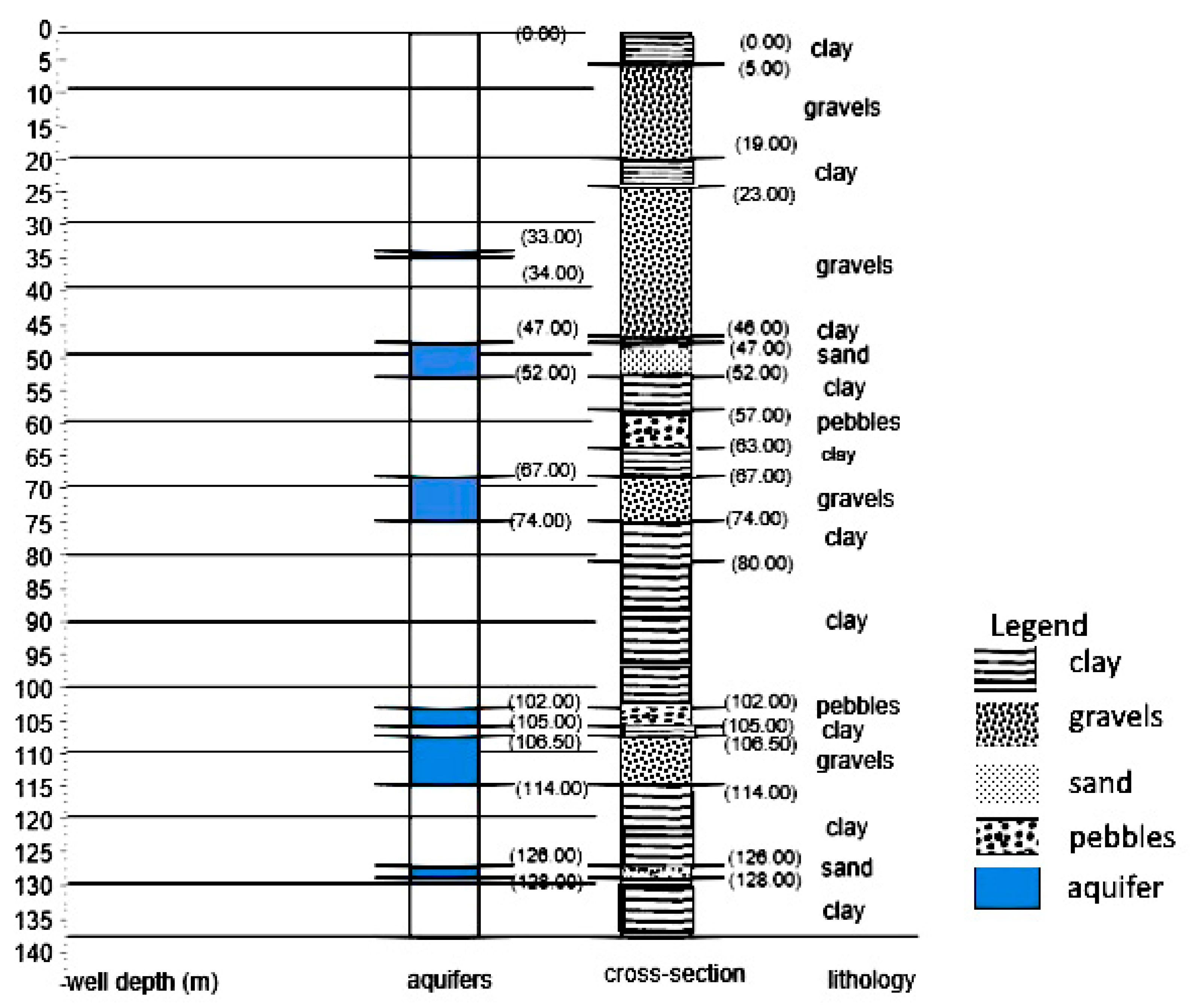
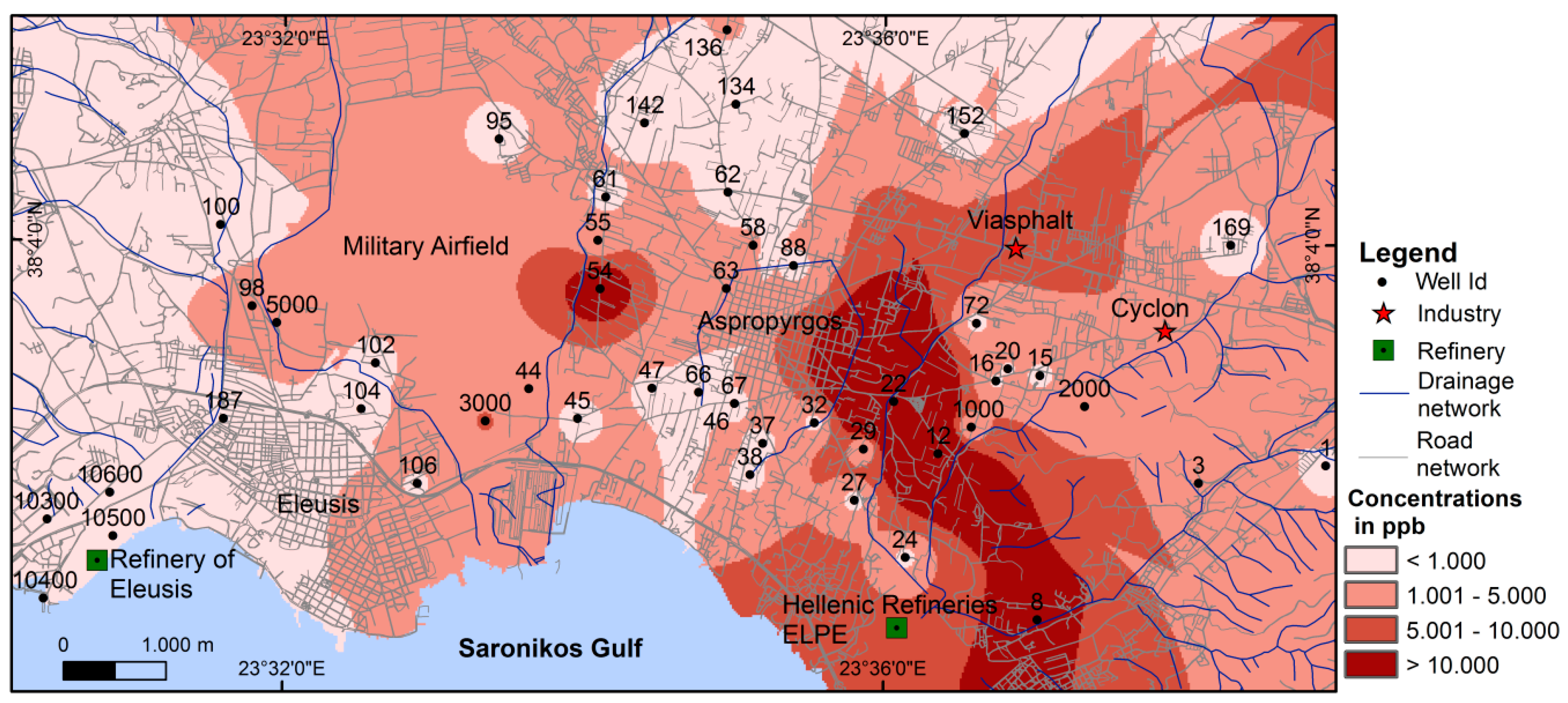
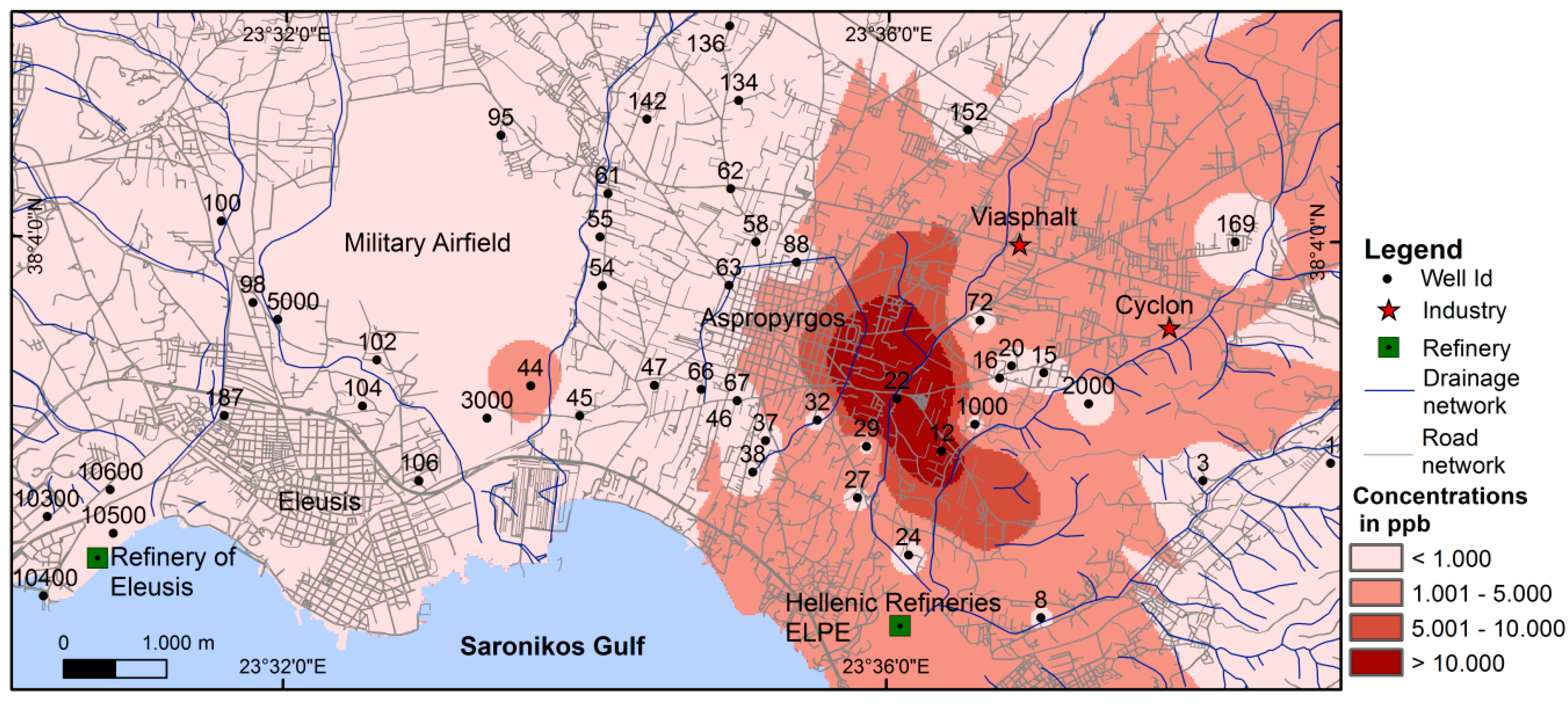

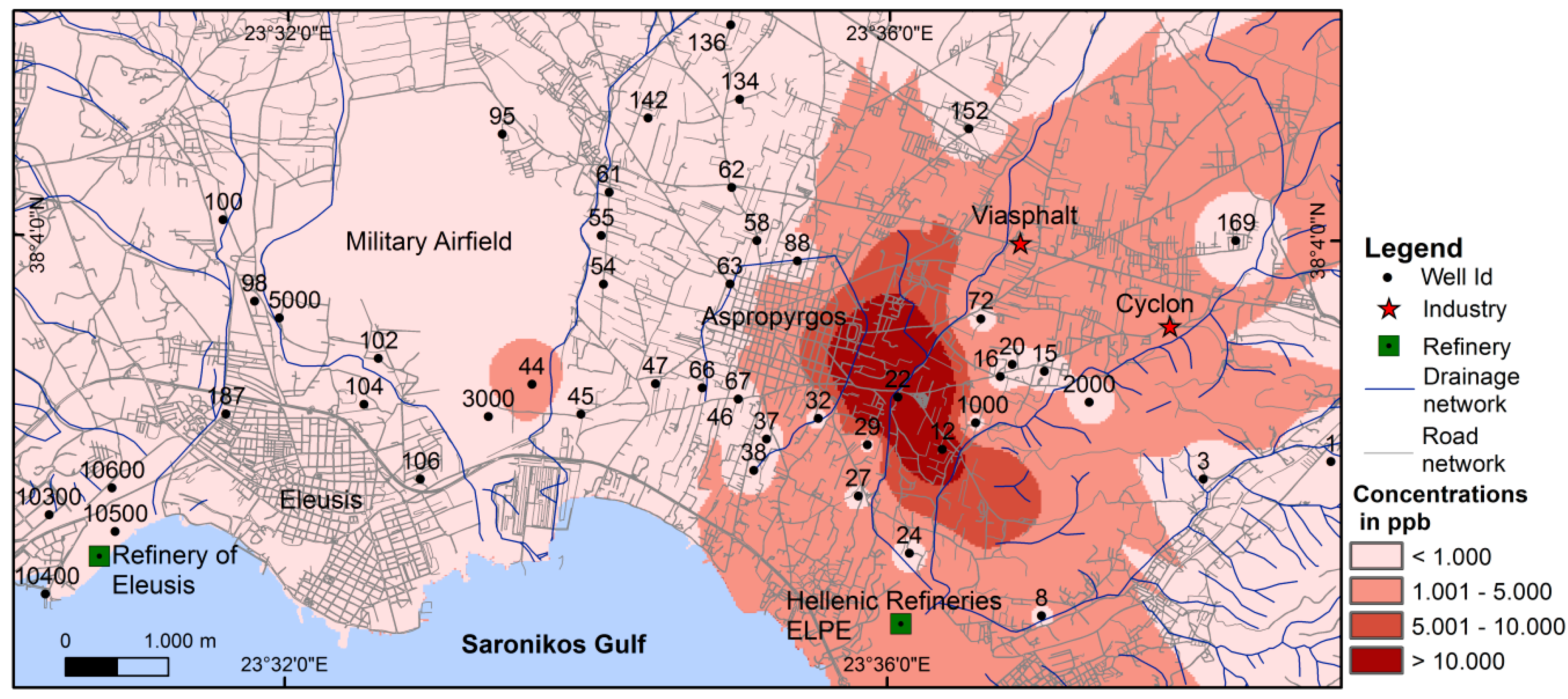
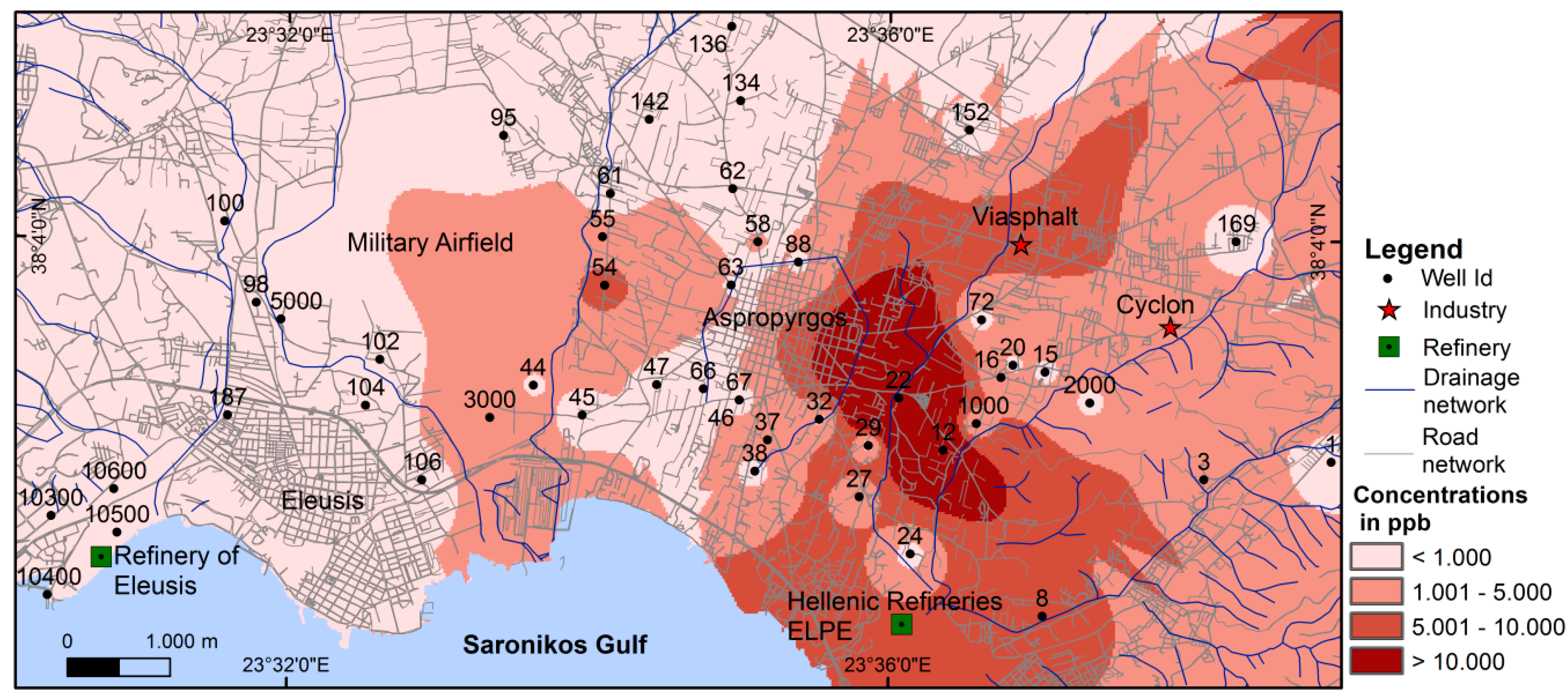
| EU (mg/L) | US EPA (mg/L) | China (mg/L) | Canada (mg/L) | New Zealand (mg/L) | Japan (mg/L) | ||
|---|---|---|---|---|---|---|---|
| Benzene | 0.001 | 0.005 | 0.01 | 0.005 | 0.01 | 0.01 | |
| Toluene | Not legislated | 1 | 0.7 | 0.024 | 0.8 | 0.2 | |
| Xylenes | Not legislated | 10 | 0.5 | 0.3 | 0. | 0.4 | |
| Ethylbenzene | Not legislated | 0.7 | 0.3 | 0.0024 | 0.3 | Not legislated |
| Well (W)/Borehole (B) Id | Age, Lithology, Aquifer Type | Hydraulic Head (M.A.S.L.) | ||||
|---|---|---|---|---|---|---|
| 03 November | 04 May | 04 November | 05 May | 05 Νοvember | ||
| 1B | Triassic carbonate (U) | 140.00 to 160.00 | ||||
| 3B | Triassic carbonate (U) | 78.00 to 80.00 | ||||
| 8W | Pleistocene sediments (C) | 4.35 | 4.68 | 4.37 | 4.77 | 4.63 |
| 12W | Pleistocene sediments (L) | 5.00 | 5.53 | 5.47 | 5.55 | 5.65 |
| 15W | Pleistocene sediments (L) | no data | ||||
| 16W | Pleistocene sediments (L) | 4.90 | 5.51 | 4.22 | 6.57 | 5.24 |
| 20W | Pleistocene sediments (L) | 4.85 | 5.35 | 4.99 | 5.47 | 4.88 |
| 22W | Pleistocene sediments (U) | 5.53 | 5.88 | no data | ||
| 23/24W | Holocene clay (U) | 5.98 | 4.15 | 4.16 | 4.01 | 3.13 |
| 27W | Holocene clay (U) | 2.91 | 3.56 | 2.82 | 3.43 | 2.91 |
| 29W | Pleistocene sediments (C) | 3.10 | 4.52 | 4.93 | 4.73 | 4.68 |
| 32W | Pleistocene sediments (L) | no data | 2.95 | 3.46 | ||
| 37W | Holocene clay (U) | 2.20 | 2.95 | 3.38 | 3.35 | 3.40 |
| 38W | Holocene clay(U) | 1.85 | 2.22 | 2.80 | 2.32 | 1.75 |
| 44W | Holocene clay (L) | 1.96 | 2.23 | 1.93 | 2.17 | 1.78 |
| 45W | Holocene clay (U) | 1.65 | 1.90 | 2.36 | 1.96 | 1.48 |
| 46W | Holocene clay (U) | 2.38 | 2.70 | 2.40 | 2.10 | 1.69 |
| 47W | Holocene clay (U) | 1.13 | 1.40 | 1.45 | 1.45 | 1.20 |
| 54W | Pleistocene sediments (L) | 4.03 | 4.56 | 4.42 | 4.69 | 4.05 |
| 55W | Pleistocene sediments (L) | 6.10 | 4.93 | 3.09 | 5.08 | 4.21 |
| 58W | Pleistocene sand with clay intercalations (C) | 3.60 | 4.10 | 4.90 | 5.13 | 3.88 |
| 61W | Pleistocene pebbles (L) | 4.96 | 5.01 | 4.74 | 4.82 | 4.52 |
| 62W | Pleistocene pebbles (L) | 5.37 | 7.19 | 5.35 | 7.10 | 6.38 |
| 63W | Pleistocene pebbles with clay intercalations (L) | 3.60 | 4.39 | 3.89 | 4.67 | 3.92 |
| 66W | Pleistocene sediments with clay intercalations (L) | 1.00 | 1.40 | 1.20 | 1.50 | 0.77 |
| 67W | Pleistocene with clay intercalations (L) | 2.40 | 2.73 | 2.45 | 2.10 | 1.69 |
| 72W | Pleistocene gravels (U) | 4.90 | 5.70 | 5.38 | 6.04 | 5.43 |
| 86/88W | Clay (L) | 3.30 | 3.90 | 4.86 | 4.96 | 5.25 |
| 95W | Pleistocene sediments (U) | 1.12 | 1.82 | 0.62 | 1.92 | 1.22 |
| 98W | Pleistocene sediments (U) | 4.98 | 5.26 | 5.03 | 5.10 | 4.61 |
| 100W | Pleistocene sediments (U) | 4.20 | 4.40 | 4.15 | 4.25 | 3.90 |
| 102W | Pleistocene pebbles (U) | 2.65 | 2.95 | 2.90 | 2.88 | 2.35 |
| 104B | Pleistocene pebbles (U) | 26.00 to 27.00 | ||||
| 106W | Holocene sediments and pebbles (U) | 0.70 | 1.20 | 0.55 | 1.28 | 1.60 |
| 134W | Pleistocene sediments (C) | 4.80 | 6.00 | 5.30 | 7.40 | 6.99 |
| 136W | Pleistocene sediments (C) | 5.20 | 6.05 | 4.95 | 5.90 | 7.01 |
| 142W | Pleistocene sediments (C) | 6.10 | 6.14 | 5.92 | 6.24 | 7.11 |
| 152W | Pleistocene sediments (C) | 95.00 to 102.00 | ||||
| 169B | Triassic carbonate (U) | 85.00 to 88.00 | ||||
| 187W | Pleistocene (U) | 3.26 | 3.76 | 3.40 | 3.74 | 3.19 |
| 1000W | Pleistocene sediments (U) | 3.66 | 4.02 | 3.95 | 4.12 | 3.89 |
| 2000W | Triassic carbonates (U) | |||||
| 3000W | Pleistocene aggregates (U) | 1.50 | 1.65 | 1.84 | 1.50 | 1,76 |
| 5000W | Pleistocene conglomerates (U) | 3.29 | 4.40 | 3.70 | 4.65 | 4,60 |
| 4000W | Pleistocene conglomerates (U) | 6.29 | 6.63 | 6.42 | 6.48 | 6.15 |
| (Petrola) 1 10300W | Holocene clay (U) | no data | 6.92 | 7.00 | no data | |
| (Petrola) 10400W | Holocene clay (U) | no data | 1.66 | 2.00 | no data | |
| (Pyrkal) 10500W | Holocene clay (U) | no data | 0.25 | 0.25 | no data | |
| (Pyrkal) 10600W | Triassic carbonate (U) | no data | 2.50 | 2.43 | no data | |
Publisher’s Note: MDPI stays neutral with regard to jurisdictional claims in published maps and institutional affiliations. |
© 2020 by the authors. Licensee MDPI, Basel, Switzerland. This article is an open access article distributed under the terms and conditions of the Creative Commons Attribution (CC BY) license (http://creativecommons.org/licenses/by/4.0/).
Share and Cite
Makri, P.; Stathopoulou, E.; Hermides, D.; Kontakiotis, G.; Zarkogiannis, S.D.; Skilodimou, H.D.; Bathrellos, G.D.; Antonarakou, A.; Scoullos, M. The Environmental Impact of a Complex Hydrogeological System on Hydrocarbon-Pollutants’ Natural Attenuation: The Case of the Coastal Aquifers in Eleusis, West Attica, Greece. J. Mar. Sci. Eng. 2020, 8, 1018. https://doi.org/10.3390/jmse8121018
Makri P, Stathopoulou E, Hermides D, Kontakiotis G, Zarkogiannis SD, Skilodimou HD, Bathrellos GD, Antonarakou A, Scoullos M. The Environmental Impact of a Complex Hydrogeological System on Hydrocarbon-Pollutants’ Natural Attenuation: The Case of the Coastal Aquifers in Eleusis, West Attica, Greece. Journal of Marine Science and Engineering. 2020; 8(12):1018. https://doi.org/10.3390/jmse8121018
Chicago/Turabian StyleMakri, Panayota, Eleni Stathopoulou, Demetrios Hermides, George Kontakiotis, Stergios D. Zarkogiannis, Hariklia D. Skilodimou, George D. Bathrellos, Assimina Antonarakou, and Michael Scoullos. 2020. "The Environmental Impact of a Complex Hydrogeological System on Hydrocarbon-Pollutants’ Natural Attenuation: The Case of the Coastal Aquifers in Eleusis, West Attica, Greece" Journal of Marine Science and Engineering 8, no. 12: 1018. https://doi.org/10.3390/jmse8121018
APA StyleMakri, P., Stathopoulou, E., Hermides, D., Kontakiotis, G., Zarkogiannis, S. D., Skilodimou, H. D., Bathrellos, G. D., Antonarakou, A., & Scoullos, M. (2020). The Environmental Impact of a Complex Hydrogeological System on Hydrocarbon-Pollutants’ Natural Attenuation: The Case of the Coastal Aquifers in Eleusis, West Attica, Greece. Journal of Marine Science and Engineering, 8(12), 1018. https://doi.org/10.3390/jmse8121018











